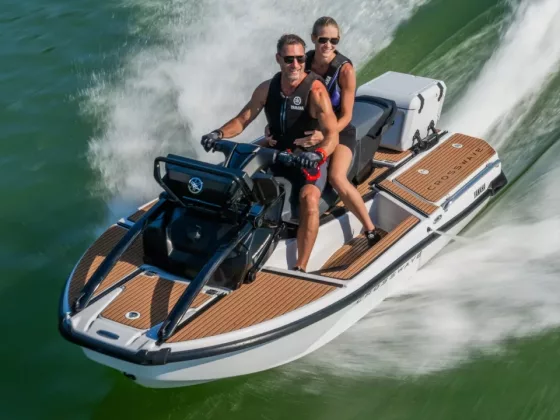Yamaha Jet Blaster: A Compact Watercraft That Changes Everything
The watercraft market just got more interesting. Yamaha's completely redesigned Yamaha Jet Blaster for 2025 replaces the entire EX line with an entirely new hull and top deck, creating something that feels fresh in a category that hasn't seen much innovation lately.
The Yamaha Jet Blaster represents more than a simple rebrand. This watercraft serves as Yamaha's answer to what younger riders actually want: something fun, affordable, and different.
Key Features

The Yamaha Jet Blaster brings several standout elements that set it apart from typical entry-level watercraft.
Core Specifications:
| Length | 118 inches (most compact sit-down WaveRunner available) |
| Width | 45 inches |
| Weight | As light as 529 pounds |
| Engine | 1049cc TR-1 marine engine (90hp or 110hp variants) |
| Fuel Capacity | 13.2 gallons |
| Seating | 1-3 persons depending on model |
The Yamaha Jet Blaster hull uses SMC fiberglass while the deck features reinforced polypropylene construction - a first for WaveRunners. This combination gives Yamaha the design flexibility they couldn't achieve with traditional materials, resulting in sharper angles and better ergonomics.
Power comes from Yamaha's proven TR-1 engine, delivering either 90 or 110 horsepower depending on the model. The engine sits in a completely redesigned pump system with upgraded impeller, housing, and nozzle components.
PRO Model Upgrades:
- Wider handlebars for better leverage
- Custom-tuned electric trim (extends to 25.5 degrees)
- Rear foot chocks for aggressive maneuvers
- 4.3" Connext display screen
Performance

The 90hp variants reach around 50 mph, while the 110hp versions can hit 53-54 mph with ease. But raw speed isn't really the point here.
The Yamaha Jet Blaster feels more solid in rough conditions and offers more precise handling compared to its main competitor. The fiberglass hull provides rigidity where it meets the water, something you notice immediately when conditions get choppy.
The handling, stability, power, and fun factor of the Yamaha Jet Blaster is unlike any other PWC in the rec-lite class, according to performance testing. The shorter hull and lighter weight make it exceptionally playful, while the electric trim system lets riders adjust the watercraft's personality from mellow to aggressive.
The fuel capacity sits at 13.2 gallons, which provides reasonable range for day trips without adding unnecessary weight.
User Experience

Thanks to its three-piece deck design, the center section can be removed in about half an hour, making the Yamaha Jet Blaster much easier to service than any other WaveRunner in Yamaha's fleet. This matters more than you might think—easier maintenance means lower costs and less downtime.
The RiDE brake and reverse system comes standard, controlled by handlebar levers. It's intuitive enough that new riders pick it up quickly, but useful enough that experienced riders appreciate it in tight spaces.
Higher trim levels include a 4.3" Connext display that provides essential information without overwhelming the rider. The screen remains readable even in bright sunlight.
The seating provides enough support and cushioning for extended rides, with adjustable handlebars to fit riders of different sizes. Storage space is limited but adequate for essentials.
Practical Information

Model Lineup and Pricing:
- Yamaha Jet Blaster (Base): $7,999 - Entry-level, 2-up seating, 90hp
- Yamaha Jet Blaster DLX: Mid-range with RiDE system, mirrors, storage upgrade
- Yamaha Jet Blaster LTD: $11,799 - Fully loaded with 110hp engine
- Yamaha Jet Blaster PRO: Performance-focused with freestyle features
The base model focuses on fun over features, while higher trims add RiDE, better displays, and performance upgrades. All models make these the most affordable WaveRunners available.The SMC hull can be repaired if damaged, offering significant cost savings compared to other brands' rec-lite models that might require complete hull replacement.
Maintenance Benefits:
- Three-piece deck design allows center section removal in 30 minutes
- Much easier engine access than traditional WaveRunner designs
- Standard Yamaha maintenance protocols apply
- Regular unleaded gasoline (no premium fuel required)
Expert Recommendation

The Yamaha Jet Blaster works best for riders who want something playful and different without the complexity or cost of larger watercraft. It's particularly suited to lakes and calmer coastal waters, where its agility shines.
While suitable for family entertainment, beginners may need help operating the Yamaha Jet Blaster due to its high-performance design and need for precise control. This doesn't necessarily present a negative—it just means riders should understand what they're getting.
For buyers considering the Sea-Doo Spark, the Yamaha Jet Blaster offers more power and better rough-water handling, though at a slightly higher price point.
Takeaway
The Yamaha Jet Blaster represents Yamaha's commitment to making watercraft more agetting. e without sacrificing the fun factor. It's compact enough to fit in smaller garages, light enough for easier trailering, and priced to attract riders who might otherwise look elsewhere.
Whether this approach succeeds depends largely on how the market responds to something genuinely different in the entry-level space. Based on early feedback, it seems like Yamaha read the room correctly.
Goes along
You might also like

The 9 Most Expensive Jet Skis in the World

Sea Bike

Arc One Electric Boat Review: What You Get for $300K

Alpacka Aleutian Packraft

The 8 Best Efoil Boards in 2025



